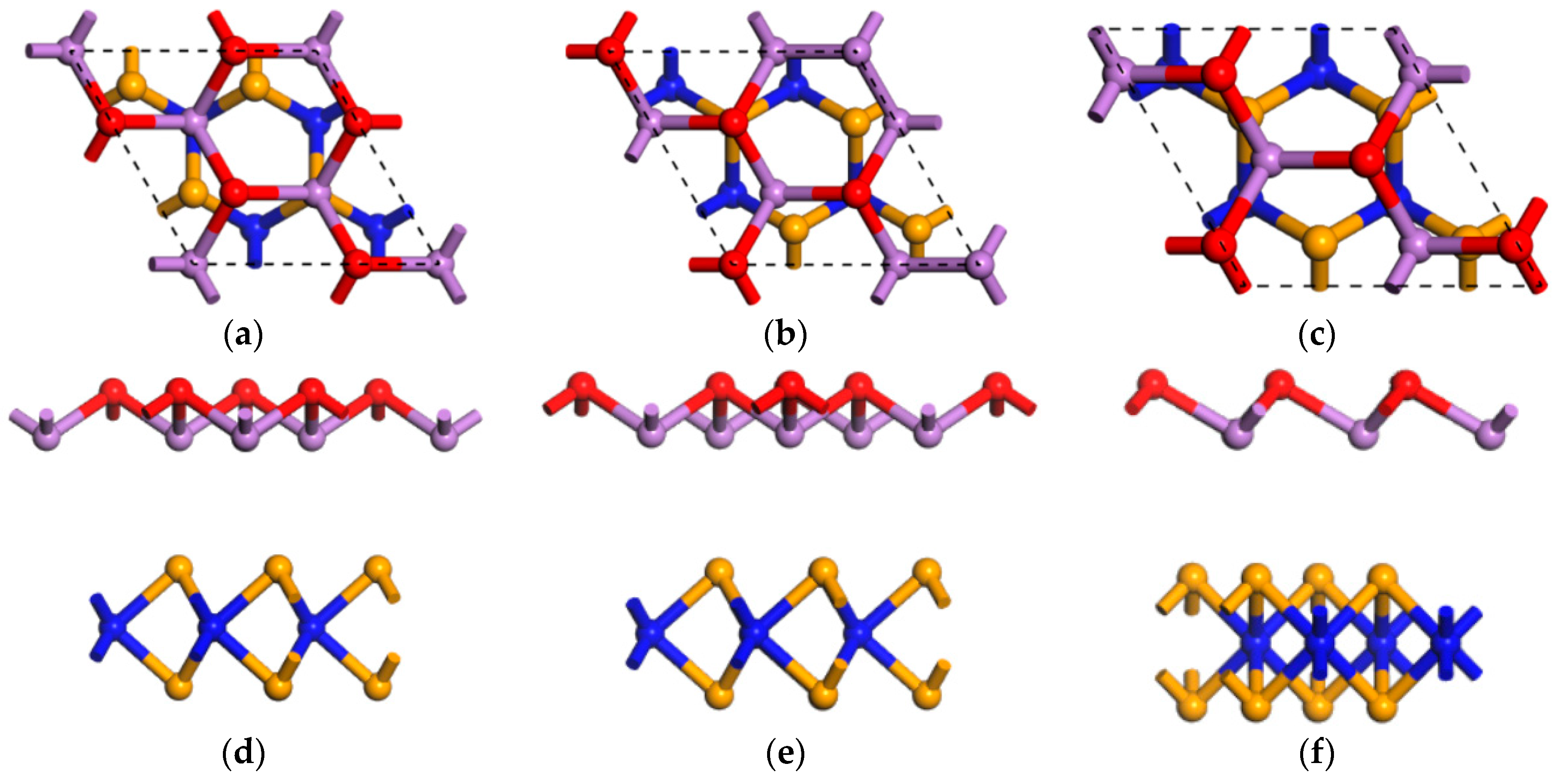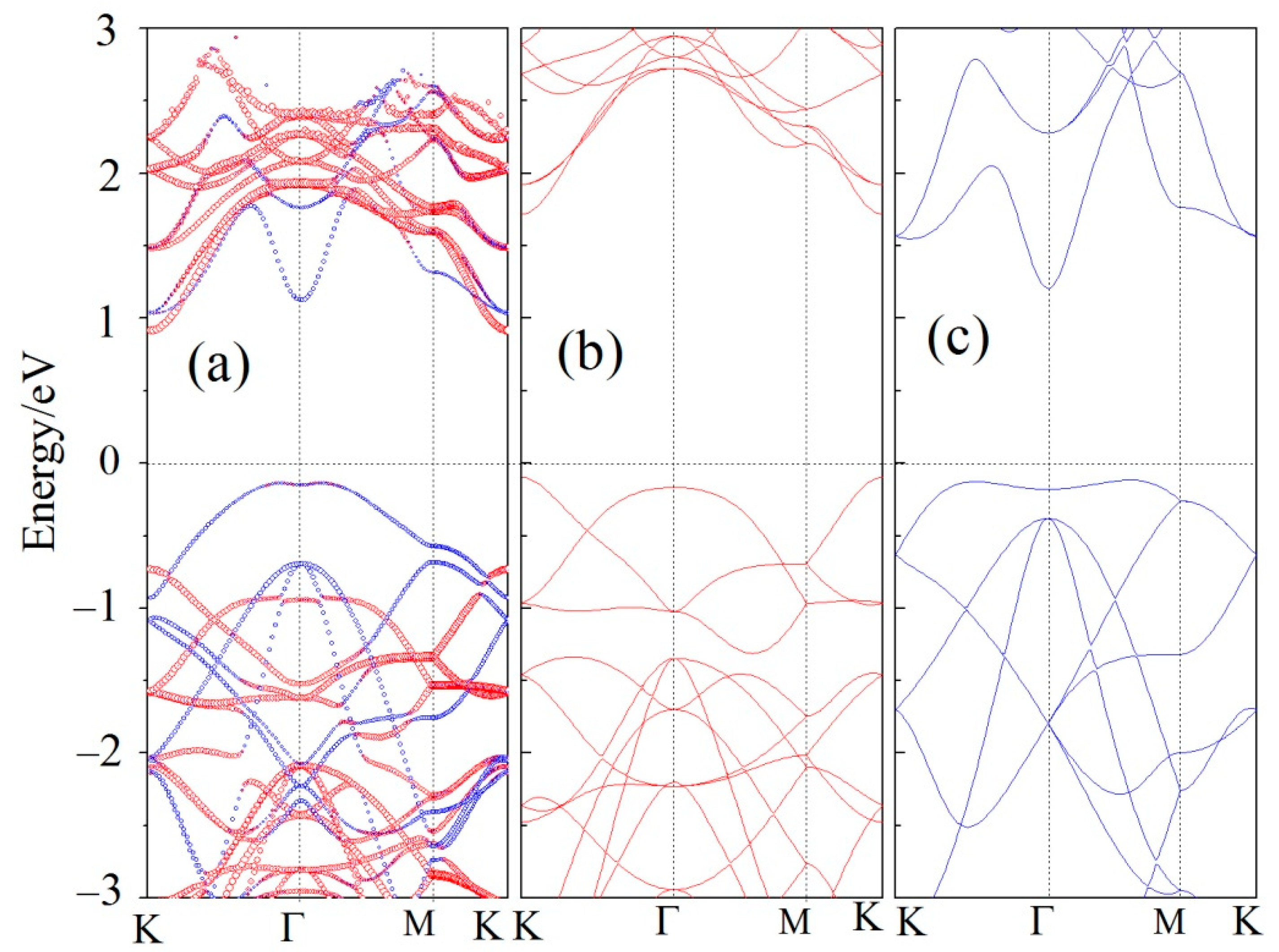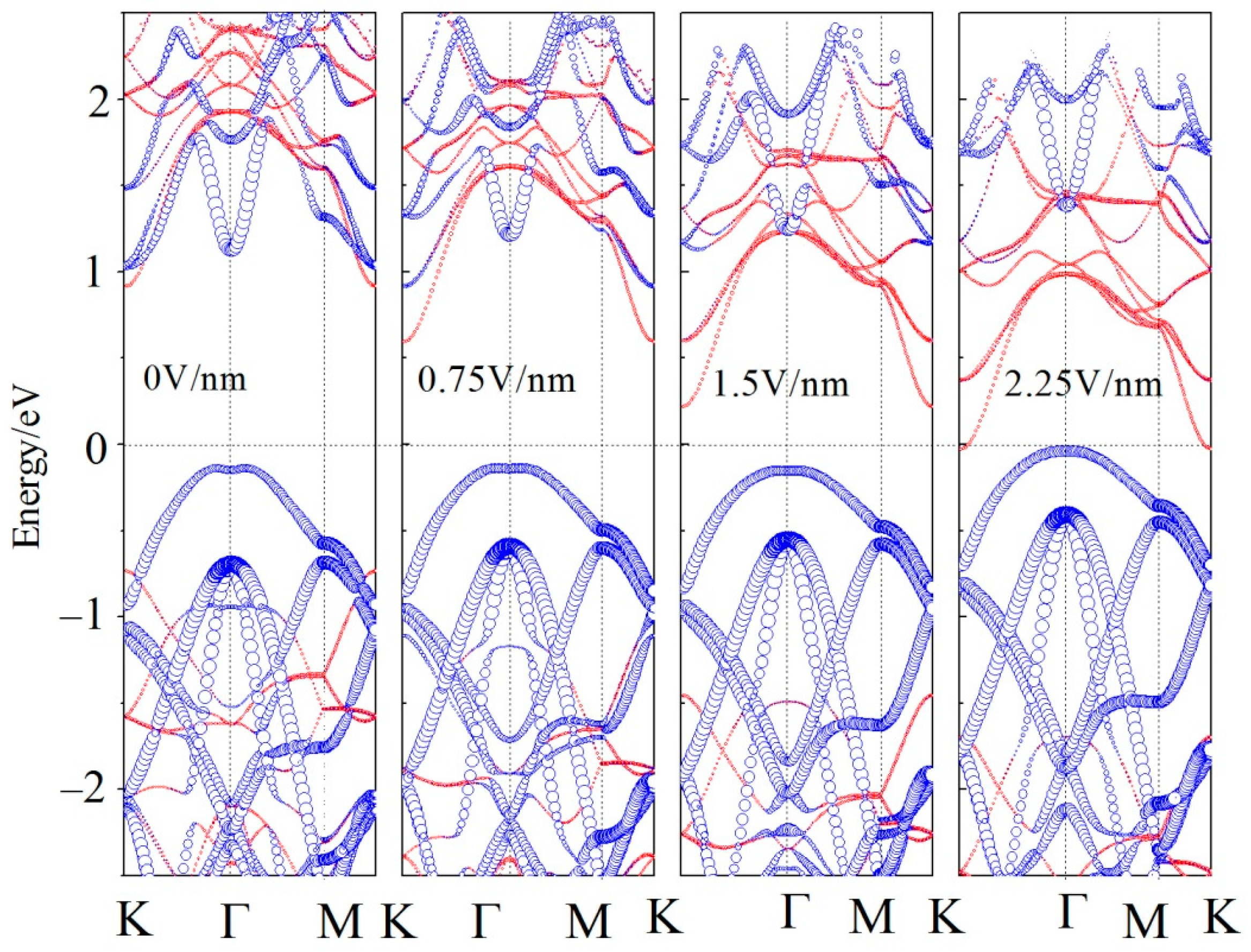Tunable Band Alignment in the Arsenene/WS2 Heterostructure by Applying Electric Field and Strain
Abstract
:1. Introduction
2. Computing Method
3. Results and Discussion
3.1. Geometric Structure of the Arsenene/WS2 Heterostructure
3.2. Electronic Properties of the Arsenene/WS2 Heterostructure
3.3. Influence of the Electric Field on Electronic Properties
3.4. The Effect of Strain on Electronic Properties
4. Conclusions
Author Contributions
Funding
Data Availability Statement
Acknowledgments
Conflicts of Interest
References
- Geim, A.K.; Novoselov, K.S. The rise of graphene. Nat. Mater. 2007, 6, 183–191. [Google Scholar] [CrossRef] [PubMed]
- Zhao, X.; Xia, C.X.; Wang, T.X.; Dai, X.Q. Electronic and magnetic properties of X-doped (X = Ti, Zr, Hf) tungsten disulphide monolayer. J. Alloys Compd. 2016, 654, 574–579. [Google Scholar] [CrossRef]
- Schwierz, F. Graphene transistors. Nat. Nanotechnol. 2010, 5, 487–496. [Google Scholar] [CrossRef] [PubMed]
- Radisavljevic, B.; Radenovic, A.; Brivio, J.; Giacometti, V.; Kis, A. Single-layer MoS2 transistors. Nat. Nanotechnol. 2011, 6, 147–150. [Google Scholar] [CrossRef] [PubMed]
- Zhao, X.; Chen, P.; Xia, C.X.; Wang, T.X.; Dai, X.Q. Electronic and magnetic properties of n-type and p-doped MoS2 monolayers. RSC Adv. 2016, 6, 16772–16778. [Google Scholar] [CrossRef]
- Gong, C.; Zhang, H.; Wang, W.; Colombo, L.; Wallace, R.M.; Cho, K. Band alignment of two-dimensional transition metal dichalcogenides: Application in tunnel field effect transistors. Appl. Phys. Lett. 2013, 103, 053513. [Google Scholar] [CrossRef]
- Roy, T.; Tosun, M.; Kang, J.S.; Sachid, A.B.; Desai, S.B.; Hettick, M.; Hu, C.C.; Javey, A. Field-Effect Transistors Built from All Two-Dimensional Material Components. ACS Nano 2014, 8, 6259–6264. [Google Scholar] [CrossRef]
- Koppens, F.H.L.; Mueller, T.; Avouris, P.; Ferrari, A.C.; Vitiello, M.S.; Polini, M. Photodetectors based on graphene, other two-dimensional materials and hybrid systems. Nat. Nanotechnol. 2014, 9, 780–793. [Google Scholar] [CrossRef]
- Hu, P.; Wen, Z.; Wang, L.; Tan, P.; Xiao, K. Synthesis of Few-Layer GaSe Nanosheets for High Performance Photodetectors. ACS Nano 2012, 6, 5988–5994. [Google Scholar] [CrossRef]
- Zhu, Z.; Guan, J.; Tomanek, D. Strain-induced metal-semiconductor transition in monolayers and bilayers of gray arsenic: A computational study. Phys. Rev. B 2015, 91, 161404. [Google Scholar] [CrossRef] [Green Version]
- Li, W.; Wang, T.X.; Dai, X.Q.; Wang, X.L.; Ma, Y.Q.; Chang, S.S.; Tang, Y.N. Tuning the Schottky barrier in the arsenene/graphene van der Waals heterostructures by electric field. Physica E 2017, 88, 6–10. [Google Scholar] [CrossRef]
- Zhang, S.; Yan, Z.; Li, Y.; Chen, Z.; Zeng, H. Atomically Thin Arsenene and Antimonene: Semimetal–Semiconductor and Indirect–Direct Band-Gap Transitions. Angew. Chem. 2015, 127, 3155–3158. [Google Scholar] [CrossRef]
- Shah, J.; Wang, W.; Sohail, H.M.; Uhrberg, R.I.G. Experimental evidence of monolayer arsenene: An exotic 2D semiconducting material. 2D Mater. 2020, 7, 025013. [Google Scholar] [CrossRef]
- Kovalska, E.; Antonatos, N.; Luxa, J.; Sofer, Z. “Top-down” Arsenene Production by Low-Potential Electrochemical Exfoliation. Inorg. Chem. 2020, 59, 11259–11265. [Google Scholar] [CrossRef] [PubMed]
- Hu, Y.; Wang, X.Z.; Qi, Z.H.; Wan, S.S.; Liang, J.C.; Jia, Q.Q.; Hong, D.C.; Tian, Y.X.; Ma, J.; Tie, Z.X.; et al. Wet Chemistry Vitrification and Metal-to-Semiconductor Transition of 2D Gray Arsenene Nanoflakes. Adv. Funct. Mater. 2021, 31, 2106529. [Google Scholar] [CrossRef]
- Zhang, S.; Xie, M.; Li, F.; Yan, Z.; Li, Y.; Kan, E.; Liu, W.; Chen, Z.; Zeng, H. Semiconducting Group 15 Monolayers: A Broad Range of Band Gaps and High Carrier Mobilities. Angew. Chem. Int. Ed. 2016, 55, 1666–1669. [Google Scholar] [CrossRef]
- Kecik, D.; Durgun, E.; Ciraci, S. Optical properties of single-layer and bilayer arsenene phases. Phys. Rev. B 2016, 94, 205410. [Google Scholar] [CrossRef]
- Wang, Y.; Ding, Y. Unexpected buckled structures and tunable electronic properties in arsenic nanosheets: Insights from first-principles calculations. J. Phys. Condens. Matter. 2015, 27, 225304. [Google Scholar] [CrossRef]
- Zhang, Z.Y.; Cao, H.N.; Zhang, J.C.; Wang, Y.H.; Xue, D.S.; Si, M.S. Orientation and strain modulated electronic structures in puckered arsenene nanoribbons. AIP Adv. 2015, 5, 067117. [Google Scholar] [CrossRef]
- Tang, W.C.; Sun, M.L.; Ren, Q.Q.; Wang, S.K.; Yu, J. Halogenated arsenenes as Dirac materials. Appl. Surf. Sci. 2016, 376, 286–289. [Google Scholar] [CrossRef]
- Zhou, X.D.; Feng, W.X.; Li, F.; Yao, Y.G. Large magneto-optical effects in hole-doped blue phosphorene and gray arsenene. Nanoscale 2017, 9, 17405–17414. [Google Scholar] [CrossRef] [PubMed]
- Pan, D.; Wang, L.; Li, Z.; Geng, B.; Zhang, C.; Zhan, J.; Yin, L.; Wang, L. Synthesis of graphene quantum dot/metal–organic framework nanocomposites as yellow phosphors for white light-emitting diodes. New J. Chem. 2018, 42, 5083–5089. [Google Scholar] [CrossRef]
- Jia, S.; Sun, H.D.; Du, J.H.; Zhang, Z.K.; Zhang, D.D.; Ma, L.P.; Chen, J.S.; Ma, D.G.; Cheng, H.M.; Ren, W.C. Graphene oxide/graphene vertical heterostructure electrodes for highly efficient and flexible organic light emitting diodes. Nanoscale 2016, 8, 10714–10723. [Google Scholar] [CrossRef] [PubMed]
- Mouri, S.; Miyauchi, Y.; Matsuda, K. Tunable Photoluminescence of Monolayer MoS2 via Chemical Doping. Nano Lett. 2013, 13, 5944–5948. [Google Scholar] [CrossRef]
- Cheng, Y.C.; Guo, Z.B.; Mi, W.B.; Schwingenschlogl, U. Prediction of two-dimensional diluted magnetic semiconductors: Doped monolayer MoS2 systems. Phys. Rev. B 2013, 87, 100401. [Google Scholar] [CrossRef]
- Lu, N.; Guo, H.; Li, L.; Dai, J.; Wang, L.; Mei, W.N.; Wu, X.; Zeng, X.C. MoS2/MX2 heterobilayers: Bandgap engineering via tensile strain or external electrical field. Nanoscale 2014, 6, 2879–2886. [Google Scholar] [CrossRef]
- Liu, Q.; Li, L.; Li, Y.; Gao, Z.; Chen, Z.; Lu, J. Tuning Electronic Structure of Bilayer MoS2 by Vertical Electric Field: A First-Principles Investigation. J. Phys. Chem. C 2012, 116, 21556–21562. [Google Scholar] [CrossRef]
- Pontes, R.B.; Miwa, R.H.; da Silva, A.J.R.; Fazzio, A.; Padilha, J.E. Layer-dependent band alignment of few layers of blue phosphorus and their van der Waals heterostructures with graphene. Phys. Rev. B 2018, 97, 235419. [Google Scholar] [CrossRef]
- Huo, N.; Wei, Z.; Meng, X.; Kang, J.; Wu, F.; Li, S.S.; Wei, S.H.; Li, J. Interlayer coupling and optoelectronic properties of ultrathin two-dimensional heterostructures based on graphene, MoS2 and WS2. J. Mater. Chem. C 2015, 3, 5467–5473. [Google Scholar] [CrossRef]
- Lan, C.Y.; Li, C.; Wang, S.; He, T.Y.; Zhou, Z.F.; Wei, D.P.; Guo, H.Y.; Yang, H.; Liu, Y. Highly responsive and broadband photodetectors based on WS2–graphene van der Waals epitaxial heterostructures. J. Mater. Chem. C 2017, 5, 1494–1500. [Google Scholar] [CrossRef]
- Sheng, Y.W.; Xu, W.S.; Wang, X.C.; He, Z.Y.; Rong, Y.M.; Warner, J.H. Mixed multilayered vertical heterostructures utilizing strained monolayer WS2. Nanoscale 2016, 8, 2639–2647. [Google Scholar] [CrossRef] [PubMed]
- Lan, C.Y.; Li, C.; Wang, S.; Yin, Y.; Guo, H.Y.; Liu, N.S.; Liu, Y. ZnO–WS2 heterostructures for enhanced ultra-violet photodetectors. RSC Adv. 2016, 6, 67520–67524. [Google Scholar] [CrossRef]
- Wang, M.; Gao, L.; Yu, P.X.; Wang, Q.; Yu, C.X.; Zhang, X.Y.; Wang, Y.H.; Zheng, W.T.; Zhang, J.Q. Synergetic interfacial passivation, band alignment, and long-term stability with halide-optimized CsPbBrxI3−x nanocrystals for high-efficiency MAPbI3 solar cells. J. Mater. Chem. C 2022, 10, 5134–5140. [Google Scholar] [CrossRef]
- Fan, C.; Yang, K.; Xu, X.; Qi, Z.D.; Jiang, S.; Xia, M.X.; Zhang, Q.L. Controllable vapor growth of CsPbBr3/CdS 1D heterostructures with type-II band alignment for high-performance self-powered photodetector. CrystEngComm 2022, 24, 275–283. [Google Scholar] [CrossRef]
- Peng, P.; Milliron, D.J.; Hughes, S.M.; Johnson, J.C.; Alivisatos, A.P.; Saykally, R.J. Femtosecond Spectroscopy of Carrier Relaxation Dynamics in Type II CdSe/CdTe Tetrapod Heteronanostructures. Nano Lett. 2005, 5, 1809–1813. [Google Scholar] [CrossRef]
- Wang, Z.; Yin, H.; Jiang, C.; Safdar, M.; He, J. ZnO/ZnSxSe1−x/ZnSe double-shelled coaxial heterostructure: Enhanced photoelectrochemical performance and its optical properties study. Appl. Phys. Lett. 2012, 101, 253109. [Google Scholar] [CrossRef]
- Wang, F.; Wang, Z.; Xu, K.; Wang, F.; Wang, Q.; Huang, Y.; Yin, L.; He, J. Tunable GaTe-MoS2 van der Waals p–n Junctions with Novel Optoelectronic Performance. Nano Lett. 2015, 15, 7558–7566. [Google Scholar] [CrossRef]
- Cao, T.; Luo, L.T.; Huang, Y.F.; Ye, B.; She, J.C.; Deng, S.Z.; Chen, J.; Xu, N.S. Integrated ZnO Nano-Electron-Emitter with Self-Modulated Parasitic Tunneling Field Effect Transistor at the Surface of the p-Si/ZnO Junction. Sci. Rep. 2016, 6, 33983. [Google Scholar] [CrossRef]
- Blöchl, P.E. Projector augmented-wave method. Phys. Rev. B 1994, 50, 17953. [Google Scholar] [CrossRef]
- Grimme, S. Semiempirical GGA-type density functional constructed with a long-range dispersion correction. J. Comput. Chem. 2006, 27, 1787–1799. [Google Scholar] [CrossRef]
- Kresse, G.; Furthmüller, J. Efficient iterative schemes for ab initio total-energy calculations using a plane-wave basis set. Phys. Rev. B 1996, 54, 11169. [Google Scholar] [CrossRef] [PubMed]
- Kerber, T.; Sierka, M.; Sauer, J. Application of semiempirical long-range dispersion corrections to periodic systems in density functional theory. J. Comput. Chem. 2008, 29, 2088–2097. [Google Scholar] [CrossRef]
- Hu, W.; Wang, T.; Yang, J.L. Tunable Schottky contacts in hybrid. J. Mater. Chem. C 2015, 3, 4756–4761. [Google Scholar] [CrossRef]
- Vu, T.V.; Hieu, N.V.; Phu, H.V.; Hieu, N.N.; Bui, H.D.; Idrees, M.; Amin, B.; Nguyen, C.V. Graphene/WSeTe van der Waals heterostructure: Controllable electronic properties and Schottky barrier via interlayer coupling and electric field. Appl. Surf. Sci. 2020, 507, 145036. [Google Scholar] [CrossRef]
- Nguyen, C.V. Electric gating and interlayer coupling controllable electronic structure and Schottky contact of graphene/BiI3 van derWaals heterostructure. Phys. Rev. B 2021, 103, 115429. [Google Scholar] [CrossRef]
- Tongay, S.; Fan, W.; Kang, J.; Park, J.; Koldemir, U.; Suh, J.; Narang, D.S.; Liu, K.; Ji, J.; Li, J.B.; et al. Tuning Interlayer Coupling in Large-Area Heterostructures with CVD-Grown MoS2 and WS2 Monolayers. Nano Lett. 2014, 14, 3185–3190. [Google Scholar] [CrossRef]






| Stacking | Bottom | Top | Center |
|---|---|---|---|
| D (Å) | 3.31 | 3.28 | 3.32 |
| Eb (meV) | −746.13 | −751.20 | −743.93 |
Publisher’s Note: MDPI stays neutral with regard to jurisdictional claims in published maps and institutional affiliations. |
© 2022 by the authors. Licensee MDPI, Basel, Switzerland. This article is an open access article distributed under the terms and conditions of the Creative Commons Attribution (CC BY) license (https://creativecommons.org/licenses/by/4.0/).
Share and Cite
Zhang, F.; Dai, X.; Shang, L.; Li, W. Tunable Band Alignment in the Arsenene/WS2 Heterostructure by Applying Electric Field and Strain. Crystals 2022, 12, 1390. https://doi.org/10.3390/cryst12101390
Zhang F, Dai X, Shang L, Li W. Tunable Band Alignment in the Arsenene/WS2 Heterostructure by Applying Electric Field and Strain. Crystals. 2022; 12(10):1390. https://doi.org/10.3390/cryst12101390
Chicago/Turabian StyleZhang, Fang, Xianqi Dai, Liangliang Shang, and Wei Li. 2022. "Tunable Band Alignment in the Arsenene/WS2 Heterostructure by Applying Electric Field and Strain" Crystals 12, no. 10: 1390. https://doi.org/10.3390/cryst12101390





